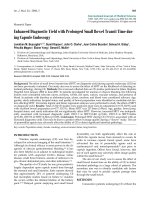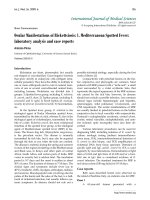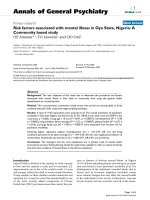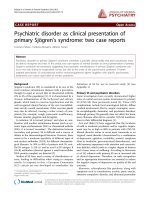Báo cáo y học: "Gastrointestinal stromal tumors with pseudocystic change mimicking a pancreatic tumor: two case reports" ppt
Bạn đang xem bản rút gọn của tài liệu. Xem và tải ngay bản đầy đủ của tài liệu tại đây (1.09 MB, 4 trang )
Case report
Open Access
Gastrointestinal stromal tumors with pseudocystic change
mimicking a pancreatic tumor: two case reports
Ursula Pauser
1
*, Sebastian Hinz
2
, Hartmut Merz
1
and Alfred C Feller
1
Address:
1
Department of Pathology, University of Lübeck, Lübeck, Germany and
2
Department of Surgery, University of Kiel, Kiel, Germany
Email: UP - ; SH - ; HM - ; ACF -
* Corresponding author
Published: 7 May 2009 Received: 17 April 2008
Accepted: 22 January 2009
Journal of Medical Case Reports 2009, 3:7592 doi: 10.1186/1752-1947-3-7592
This article is available from: />© 2009 Pauser et al; licensee Cases Network Ltd.
This is an Open Access article distributed under the terms of the Creative Commons Attribution License (
/>which permits unrestricted use, distribution, and reproduction in any medium, provided the original work is properly cited.
Abstract
Introduction: Cystic lesions of the upper abdomen normally develop from pancreatic tissue. The
differential diagnoses include neoplastic and non-neoplastic lesions. Pseudocystic tumors that
secondarily involve the pancreas are very rare and may lead to diagnostic pitfalls.
Case presentation: A 51-year-old woman and a 65-year-old man, both German, presented with
abdominal cystic lesions suspected to be pancreatic pseudocysts. Both tumors were classified as
gastrointestinal stromal tumors, epithelioid subtype. In one case, tumor origin in the gastric wall was
confirmed by relaparotomy. In the other case, a point mutation in PDGFRalpha gene, exon 18 proved
the diagnosis of gastrointestinal stromal tumor. The tumors were resected and both patients are still
alive and disease-free.
Conclusions: The differential diagnosis of cystic lesions in the upper abdomen must include
gastrointestinal stromal tumors with pseudocystic change. The origin of a large cystic gastrointestinal
stromal tumor may be difficult to determine. Epithelioid tumor pattern, weak or absent KIT
expression and detection of PDGFRalpha mutation are typical diagnostic parameters of gastric
gastrointestinal stromal tumors.
Introduction
Cystic lesions of the pancreas are usually pseudocysts,
related to chronic pancreatitis. Some are inflammatory
pseudotumors with regressive cystic change; others are
solid-pseudopapillary tumors or serous or mucinous cystic
neoplasms of the pancreas.
The diagnostic spectrum of pancreatic cystic lesions has
been well investigated. Recently, we introduced a new
entity entitled solid and cystic pancreatic hamartomas
with a review of the literature [1]. The diagnoses and
malignant potential of cystic le sions are sometimes
difficult to predict, but in general, they are simply
Page 1 of 4
(page number not for citation purposes)
classified by their histology. The following cases demon-
strate pancreatic cystic lesions that secondarily involved
the pancreas. The histological, immunohistochemical and
molecular investigation led to the diagnosis of gastro-
intestinal stromal tumor (GIST) with pseudocystic change.
The difficulties of tumor diagnosis and tumor origin are
discussed.
Case presentation
Case 1
A 51-year-old woman presented with a palpable abdom-
inal mass on physical examination. From a computed
tomography (CT) scan, a cystic tumor, 20cm in diameter,
was notes to be present between the stomach and the
pancreas. With endosonography, the pancreas was inho-
mogeneous like chronic pancreatitis. Suspected of being a
pancreatic pseudocyst, the mass was resected. Necrotic
material and multiple solid nodules up to 3cm in diameter
were present. Histological examination revealed an
epithelioid neoplasm, resembling a neuroendocrine
tumor. Immunohistochemical analysis indicated the
characteristic antigen expression pattern of mesenchymal
tumors (positivity of vimentin). A postoperative control
CT detected a residual tumor. Relaparotomy was per-
formed with complete tumor resection and wedge resection
of the gastric wall. The resected specimen demonstrated
multiple 0.5cm gray tumor nodules within a 4cm in
diameter hemorrhagic mouldered area. Histologically, the
solid tumor component was well circumscribed and multi-
lobated with fibrous septae, extensive sclerosis, diffuse
hemorrhage and pseudocystic degeneration. The histo-
logical growth pattern was predominantly epithelioid
(Figure 1). The tumor cells showed centrally located
round to oval nuclei with discrete nucleoli and a moderately
broad rim of eosinophil cytoplasm. Mitoses were very rare
(1/50HPF). Some apoptotic figures were seen. The tumor
was well vascularized with an interspersed chronic lympho-
cytic inflammatory infiltrate adjacent to regular pancreatic
tissue. The tumor cells showed strong cytoplasmic staining
for the immunohistochemical markers vimentin and CD34
and focally and weak reaction for KIT. Cytokeratin and the
neuroendocrine marker synaptophysin were not detected.
Expression of the neural marker S100 protein and smooth
muscle marker SMA was also lacking. Proliferative activity,
identified by Ki-67, was 5%. Sequence analyses of c-kit exons
9 and 11 and PDGFRalpha exons 12 and 18 were carried out.
A mutation was not detected.
Case 2
A 65-year-old man with slight abdominal discomfort was
examined by ultrasonography, which revealed a well-
demarcated pancreatic cystic tumor, 10cm in diameter.
Three nodules were resected for histological examination.
The specimens were solid, gray-brown and up to 3cm in
diameter. The tumor presented an epithelioid growth
pattern (Figure 2) with necrosis, hemorrhage and a chronic
inflammatory infiltrate. The mitotic rate was 1/50HPF.
Immunohistochemical co-expression of vimentin, CD34
and BCL-2 was detected. The reaction product of KIT was
weak, but typically cytoplasmatic dots were seen (Figure 3).
The proliferative activity detected with Ki-67 was 5%. Other
epithelial and mesenchymal markers were negative (for
details, see Table 1). Sequence analyses of c-kit and
PDGFRalpha gene revealed a point mutation in PDGFRalpha
exon 18 (D842V). These results confirmed the diagnosis of
GIST.
Five months later, control CT found a 5.3cm diameter well
demarcated inhomogeneous cystic mass projecting into
the lesser sac. Relaparotomy located the residual tumor
between the stomach and pancreas. Infiltration of the
digestive tract was not observed. The tumor was resected
completely. There was a multipart mouldered gray-brown
mass 3cm in diameter. Histological diagnosis confirmed
residual epithelioid GIST with pseudocystic change.
Discussion
The two cases presented here were clinically diagnosed as
pancreatic cystic lesions. They were suspected of being
pancreatic pseudocysts, due to chronic pancreatitis.
Histologically, they showed a solid epithelioid growth
pattern resembling a pancreatic neuroendocrine tumor,
but lacked epithelial and neuroendocrine markers in the
immunohistochemistry. A pancreatic carcinoma was
excluded. Instead, the tumors revealed me senchymal
differentiation, but well known mesenchymal entities of
the pan creas, that is, lei omyosarco ma or ma lignant
Figure 1. Epithelioid gastrointestinal stromal tumor with
sclerosis, an interspersed chronic lymphocytic inflammatory
infiltrate and hemosiderin. Tumor cells with round to oval
nuclei, discrete nucleoli and a moderately broad rim of
eosinophilic cytoplasm (hematoxylin and eosin staining; case 1).
Page 2 of 4
(page number not for citation purposes)
Journal of Medical Case Reports 2009, 3:7592 />peripheral nerve sheath tumor, were n ot shown on
immunohistochemistry [2]. Moreover, there was no
evidence for an inflammatory pseudotumor as discussed
earlier [3]. Co-expression of CD34, KIT and BCL-2
characterizes the diagnosis of GISTs and extragastrointest-
inal stromal tumors (EGISTs). The latter are a small subset
(5%) of GISTs that originate outside the gastrointestinal
tract. EGISTs are predominantly located in the omentum
and mesentery (80%), but also in the retroperitoneum [4,
5]. However, a GIST of the pancreas with infiltration of the
duodenal wall has been reported [6]. We argue that this
tumor, which was 10cm in diameter, might resemble a
gastric or duodenal GIST, which infiltrated the pancreas
secondarily. The origin was not proven definitely. Doctors
should be wary of diagnosing a primary GIST of the
pancreas, especially when the tumor is large and a gastric
or intestinal GIST is not excluded.
In our two cases, epithelioid growth pattern, weak KIT
expression and low proliferative activity was suspicious for
gastric GIST. In case one, the tumor origin in the stomach
was confirmed at relaparotomy. In case two, a point
mutation in PDGFRalpha exon 18 strengthened the
diagnosis of GIST, evolving in the stomach, since this
mutation was detected predominantly in gastric GISTs
with epithe lioid growth patt ern [7]. Moreover, this
peculiar tumor subtype has a low mitotic rate and
favorable prognosis [7, 8], as seen in our two cases. Both
GISTs were resected completely and the patients have had
a relapse-free follow-up so far (8 and 3 years). Based on
the low mitotic rate (1 Mitosis/50HPF), we classified the
tumor risk of malignancy as low to intermediate according
to Fletcher’s criteria [9]. The prognostic marker tumor size
must be discussed. The large tumors measured with
ultrasound (20cm and 10cm in diameter, respectively)
included a cystic appearance. In contrast to this, the solid
tumor part of the resected specimen was considerably less
than 10cm in diameter (about 4cm in case 1 and 5cm in
case 2). The clinically described cysts were due to regressive
changes of tumor tissue and are termed pseudocysts. The
tumor was typically necrotic and hemorrhagic. An
epithelial lining as defined in cysts was not seen.
Figure 2. Epithelioid gastrointestinal stromal tumor with
a mild lymphocytic infiltrate (hematoxylin and eosin staining;
case 2).
Figure 3. Weak cytoplasmic expression of KIT with
single paranuclear dots (case 2). A-C: original magnification
×400.
Table 1. Immunohistochemical panel with staining results in case 1 and case 2
Antigen Working dilution Mono-, polyclonal Source Case 1 Case 2
Vimentin 1.50 M Dako Pos Pos
KIT 1:50 P Dako Pos Pos
CD34 1:500 Immunotech, Marseille, France Pos Pos
Bcl-2 1:25 P Dako Pos Pos
Synaptophysin 1:20 M Dako Neg Neg
CAM5.2 1:10 M Becton Dickinson, Franklin Lakes, NJ, USA Neg Neg
SMA 1:20 Dako Neg Neg
S100 1:500 P Dako Neg Neg
Ki-67 1:100 Dako 5% 5%
Page 3 of 4
(page number not for citation purposes)
Journal of Medical Case Reports 2009, 3:7592 />Conclusions
The differential diagnoses of pancreatic cystic lesions must
include GISTs with pseudocystic changes. The origin of
large GISTs in the upper abdomen may be difficult to
determine, especially when located between the stomach,
duodenum and pancreas. A weak or absent expression of
KIT should not exclude the diagnosis of GIST, since this is
characteristic for gastric GISTs with epithelioid differentia-
tion. Mutation analyses are helpful in such cases.
Consent
Written informed consent was obtained from the patients
for publication of these case reports and any accompany-
ing images. A copy of the written consent is available for
review by the Editor-in-Chief of this journal. The retro-
spective study was undertaken in accordance with institu-
tional guidelines. Informed consent for scientific
evaluation had been obtained from patients at their
primary clinical treatment.
Competing interests
The authors declare that they have no competing interests.
Authors’ contributions
UP drafted the manuscript, carried out the immunohisto-
chemical staining, the molecular analysis, researched the
literature and took the photographs. SH contributed the
clinical data. HM and AF revised the manuscript critically
for important intellectual content. All authors read and
approved the final manuscript.
Acknowledgements
We are grateful to Günter Klöppel who provided the
paraffin blocks from the Pathology Department at Kiel. We
would like to thank Maike Pacena, Anja Bredtmann (Kiel)
and Christian Kähler (then i n Lübeck) for techn ical
assistance.
References
1. Pauser U, Kosmahl M, Kruslin B, Klimstra DS, Klöppel G: Pancreatic
solid and cystic hamartoma in adults: Characterization of a
new tumorous lesion. Am J Surg Pathol 2005, 29:797-800.
2. Pauser U, Kosmahl M, Sipos B, Klöppel G: Mesenchymal tumors of
the pancreas Überraschend, aber nicht ungewöhnlich. Patho-
loge 2005, 26:52-58.
3. Pauser U, da Silva MT, Placke J, Klimstra DS, Kloppel G: Cellular
hamartoma resembling gastrointestinal stromal tumor: a
solid tumor of the pancreas expressing c-kit (CD117). Mod
Pathol 2005, 18:1211-1216.
4. Miettinen M, Monihan JM, Sarlomo-Rikala M, Kovatich AJ, Carr NJ,
Emory TS, Sobin LH: Gastrointestinal stromal tumors/smooth
muscle tumors (GISTs) primary in the omentum and
mesentery: clinicopathologic and immunoh istochemical
study of 26 cases. Am J Surg Pathol 1999, 23:1109-1118.
5. Reith JD, Goldblum JR, Lyles RH, Weiss SW: Extragastrointestinal
(soft tissue) stromal tumors: an analysis of 48 cases with
emphasis on histologic predictors of outcome. Mod Pathol
2000, 13:577-585.
6. Daum O, Klecka J, Ferda J, Treska V, Vanecek T, Sima R, Mukensnabl
P, Michal M: Gastrointestinal stromal tumor of the pancreas:
case report with documentation of KIT gene mutation.
Virchows Arch 2005, 446:470-472.
7. Wardelmann E, Hrychyk A, Merkelbach-Bruse S, Pauls K, Goldstein J,
Hohenberger P, Losen I, Manegold C, Buttner R, Pietsch T:
Association of platelet-derived growth factor receptor
alpha mutations with gastric primary site and epithelioid or
mixed cell morphology in gastrointestinal stromal tumors.
J Mol Diagn 2004, 6:197-204.
8. Lasota J, Dansonka-Mieszkowska A, Sobin LH, Miettinen M: A great
majority of GISTs with PDGFRA mutations represent gastric
tumors of low or no malignant potential. Lab Invest 2004,
84:874-883.
9. Fletcher CD, Berman JJ, Corless C, Gorstein F, Lasota J, Longley BJ,
Miettinen M, O’Leary TJ, Remotti H, Rubin BP, Shmookler B, Sobin
LH, Weiss SW: Diagnosis of gastrointestinal stromal tumors: A
consensus approach. Hum Pathol 2002, 33:459-465.
Page 4 of 4
(page number not for citation purposes)
Journal of Medical Case Reports 2009, 3:7592 />Do you have a case to share?
Submit your case report today
• Rapid peer review
• Fast publication
• PubMed indexing
• Inclusion in Cases Database
Any patient, any case, can teach us
something
www.casesnetwork.com









